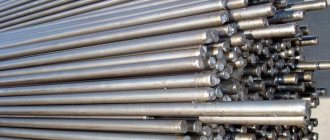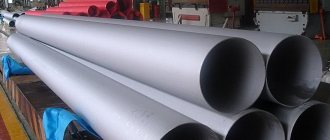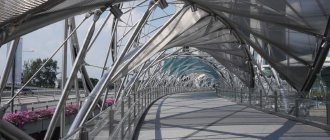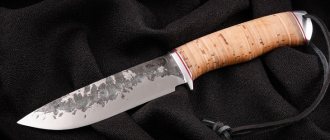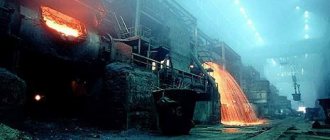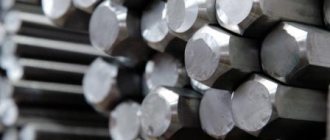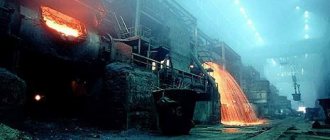Basic information about heat-resistant and heat-resistant alloys
Heat-resistant alloys and steels are materials that operate at high temperatures for a given period of time under complex stress conditions and have sufficient resistance to corrosion in gas environments.
Heat-resistant alloys and steels are materials that operate in an unloaded or lightly loaded state at elevated temperatures (more than 550 °C) and are resistant to corrosion in gas environments.
Active interest in such materials began to appear in the late 30s of the 20th century, when the need arose for materials capable of operating at fairly high temperatures. This is due to the development of jet aircraft and gas turbine engines.
The basis of heat-resistant and heat-resistant alloys can be nickel, cobalt, titanium, iron, copper, aluminum. Nickel alloys are the most widely used. They can be cast, deformed and powder. The most common among heat-resistant ones are cast complex alloyed nickel-based alloys, capable of operating at temperatures of 1050-1100 °C for hundreds and thousands of hours under high static and dynamic loads.
Main types
The most common alloys are iron-based. These are chromium, chromium-nickel, and chromium-manganese steels with molybdenum, titanium and tungsten additives. Alloys with alloying elements such as aluminum, niobium, vanadium, and boron are also produced, but in smaller quantities.
In most cases, the percentage of additives added to steel reaches from 15 to 50%
The second, very popular group is nickel-based alloys. Chromium is used as an additive. Heat resistance is also increased by the addition of titanium, cerium, calcium, boron and similar elements. In certain technological complexes, alloys based on nickel and molybdenum are in demand.
The third group includes heat-resistant cobalt-based alloys. The alloying elements for them are carbon, tungsten, niobium, and molybdenum.
In metallurgy, there are a number of materials that are used in alloying steels:
- chromium;
- nickel;
- molybdenum;
- vanadium;
- niobium;
- titanium;
- manganese;
- Tungsten;
- silicon;
- tantalum;
- aluminum;
- copper;
- boron;
- cobalt;
- zirconium.
Rare earth elements are widely used.
Chemical composition
Determining the chemical composition of heat-resistant materials is a complex process. It is necessary to take into account not only the main alloying elements, but also what enters the product as impurities or remains as a result of chemical reactions that occur during smelting.
Specially added alloying elements are introduced to obtain the required technological, physical and mechanical properties. And impurities and chemical elements formed during smelting can worsen the properties of high-alloy metal.
For chromium-nickel alloys and refractory materials based on cobalt, the presence of sulfur of more than 0.005%, traces of tin, lead, antimony and other fusible metals is dangerous.
Structure and properties
Heat resistance is determined not only by the chemical composition of the metals, but also by the form in which impurities are present in the alloy. For example, sulfur in the form of nickel sulfides lowers the melting point. And the same sulfur, combined with zirconium, cerium, magnesium, forms refractory structures. The purity of nickel or chromium has a great influence on heat resistance. However, it should be taken into account that the properties of alloys vary depending on the technology used.
The main property by which the heat resistance of a material is determined is creep. This is the phenomenon of permanent deformation under continuous stress. The resistance of the material to destruction under the influence of temperature.
heat-resistant alloy 6 letters
| Nichrome | Heat-resistant alloy 6 letters |
| Bronze | An alloy of copper, usually with tin as the main alloying element, but alloys with aluminum, silicon, beryllium, lead and other elements except zinc and nickel are also used. The name "bronze" comes from Italian. bronzo which, in turn, either came from the Persian word “berenj”, meaning “brass”, or from the name of the city of Brindisi, from which this material was delivered to Rome 6 letters |
| Electr | Natural alloy of gold and silver; magnesium alloy 6 letters |
| Nichrome | General name of a group of alloys consisting, depending on the brand of alloy, of 55-78% nickel, 15-23% chromium, with additions of manganese, silicon, iron, aluminum 6 letters |
| Bronze | Artwork made from such an alloy 6 letters |
| Bronze | Alloy of copper with tin and some other elements 6 letters |
| Zapan | Fencing on the water for storing and sorting timber; floating barrier across the river during timber rafting 6 letters |
| Brass | Alloy of copper with zinc and other elements 6 letters |
| Solder | Metal or alloy for filling gaps when soldering 6 letters |
| Antimony | Chemical element, silvery-white metal, used. in various alloys in technology, in typography 6 letters |
Classification of heat-resistant and heat-resistant alloys
Since we are talking about heat-resistant and heat-resistant steels and alloys, it is worth defining the terms heat resistance and heat resistance.
Terms and Definitions
Heat resistance is the ability of steels and alloys to withstand mechanical loads at high temperatures for a certain time. At temperatures up to 600°C, the term heat resistance is usually used. A more strict definition of heat resistance can be given.
Heat resistance is also understood as a stress that causes a given deformation, without leading to destruction, that a metal material in a structure can withstand at a certain temperature for a given period of time. If time and stress are taken into account, the characteristic is called the long-term strength limit; if time, stress and deformation are the creep limit.
Creep is a phenomenon of continuous deformation under constant stress. Long-term strength is the resistance of a material to destruction under prolonged exposure to temperature.
Heat resistance characterizes the resistance of metals and alloys to gas corrosion at high temperatures.
Classification
There are several classifications of alloys and steels that operate at elevated and high temperatures.
The most general is the following classification of heat-resistant and heat-resistant steels and alloys:
- Heat-resistant steels - operate under load at temperatures up to 600°C for a long time. An example is carbon, low-alloy and chromium steels of the ferritic class.
- Heat-resistant steels and alloys - work under load at high temperatures for a certain time and at the same time have sufficient heat resistance. Examples are austenitic steels on a chromium-nickel or chromium-nickel-manganese base with various alloying elements and alloys on a nickel or cobalt base.
- Heat-resistant (scale-resistant) steels and alloys - operate in an unloaded or lightly loaded state at temperatures above 550°C and are resistant to chemical destruction of the surface in gaseous environments. Examples include chromium-silicon steels of the martensitic class, chromium-nickel austenitic steels, chromium and chromium-aluminum steels of the ferritic class, as well as alloys based on chromium and nickel.
There is also a classification according to production method:
- foundries;
- deformable.
Heat-resistant alloy, 6 letters, 2 letter “I”, crossword clue
6 letter word, first letter is “H”, second letter is “I”, third letter is “X”, fourth letter is “R”, fifth letter is “O”, sixth letter is “M”, letter word "N", the last "M". If you don’t know a word from a crossword or scanword, then our site will help you find the most difficult and unfamiliar words.
Guess the riddle:
What kind of bird is this?
He never builds nests for himself, leaves eggs for his neighbors, and does not remember the chicks. Show answer >> Who's buzzing in the chimney in winter? Show answer>>
Who wanders through the forest angry and hungry in the cold winter? Show answer>>
Other meanings of this word:
- Ni+Cr
- Heat-resistant alloy for electric stoves
- Heat-resistant alloy
- General name for a group of alloys consisting, depending on the brand of alloy, of 55-78% nickel, 15-23% chromium, with additions of manganese, silicon, iron, aluminum
- Alloy for spirals
- Nickel chromium alloy
- Nickel-chromium alloy for the manufacture of heating elements
- Nickel alloy with chromium, iron and manganese
- An alloy of nickel, iron and chromium, non-oxidizing at both normal and high temperatures
Random riddle:
That yesterday was “tomorrow”, and tomorrow will be “yesterday”?
Show answer>>
Random joke:
Two teenagers hug in the front seat of a car. Things go far, and the guy whispers to his girlfriend: “Would you like to move into the back seat?” “No,” she answers.
The embarrassed guy continues in the same vein and, seeing that everything is going as it should, repeats his question: “Would you like to move to the back seat?” - Don't want. The guy was completely embarrassed, but he didn’t show it and continued to caress. After a while, seeing that the girl is clearly ready for anything, he asks again: “Would you like to move into the back seat?” - No. - But why? - I want to be here with you! More jokes>>
Did you know?
Brain. The brain of women in 1860 was 1245 grams and today has increased to 1270 grams.
More facts>>
Types of heat-resistant steel
- Ferritic - has a low chromium content (no more than 17%). Has average corrosion resistance. Poorly processed.
- Martensitic - has a low chromium content and medium carbon content. Has mediocre ductility.
- Martensitic-ferritic - has the properties of ferritic and martensitic metal, which is why it has improved characteristics.
- Austenitic - steel with low carbon content, has non-magnetic properties, contains nickel. Resistant to corrosion at high temperatures and deformations.
Types of heat-resistant and heat-resistant materials according to structural criteria
The state of the internal structure of metals determines the type of steels and alloys.
There are a number of categories of heat-resistant steel materials based on the conditions of the internal structure.
Austenitic class
The austenitic class forms an internal structure due to a high percentage of chromium and nickel. Obtaining stable austenite, a face-centered crystal lattice of iron, involves alloying steel with nickel. Heat resistance is determined by chromium additives.
This is interesting: Equal-flange angle GOST 8509 93. Defining assortment of angle
Austenitic alloys are highly alloyed. For alloying purposes, Nb (niobium) and (Ti) titanium are used to increase corrosion resistance. This characteristic allows them to be classified as stabilized. Corrosion-resistant, heat-resistant steels are difficult to machine metals.
When temperatures rise to values close to 1000 degrees C. and are maintained for a long time, austenitic stainless steel remains resistant to the formation of a layer of scale, maintaining the quality of heat-resistant materials.
Austenitic type alloys belonging to the dispersion-hardening subclass are often found in production. Qualitative characteristics can be improved by adding various elements: carbide, intermetallic hardeners. These elements provide strain-thermal hardening due to the strengthening of the austenite matrix using dispersion hardening.
Carbide-forming elements: vanadium-V, niobium-Nb, tungsten-W, molybdenum-Mo.
Intermetallic compounds are obtained due to additional additions of chromium-Cr, nickel-Ni, and titanium-Ti.
Austenite structure
Heat-resistant austenitic materials differ in structure types. She may be
- Homogeneous. A material with such a structure does not undergo heat treatment for strengthening; it contains little carbon and a large percentage of alloying components. This results in good creep resistance. Used in temperature environments below 500 degrees.
- Heterogeneous. In such a material that has undergone thermal strengthening, carbonitride and intermetallic phases are obtained. This allows you to increase the temperature of use under voltage loads up to 700 degrees.
Materials with nickel and cobalt additives are subject to operational influences at temperatures up to 900 degrees. Maintains structural stability for a long time.
Nichromes, in which nickel contains more than 55%, are distinguished by both heat resistance and heat resistance properties.
Refractory metals: tungsten, niobium, vanadium ensure the stability of metals when the thermal regime approaches 1500 degrees. WITH.
Molybdenum alloys with additional protection retain their working properties for a long time in a thermal regime of 1700 degrees.
| Precipitation-hardening grades of the austenitic series | Marking of homogeneous austenitic alloys |
| Х12Н20Т3Р, 4Х12Н8Г8МФБ, 4Х14Н14В2М | 1X14N16B, 1X14N18V2B, X18N12T, X18N10T, X23N18, X25N20S2, X25N16G7AR |
| Metals of this subclass are used to produce turbine structures, vehicle engine valves, and reinforcement structures. | Homogeneous types are used for the manufacture of pipe products, furnace parts, and units operating under pressure. |
| Х12Н20Т3Р is used for the production of turbine disks, ring components, fasteners operating at temperatures below 700 degrees. 4Х14Н14В2М participates in the production of fittings, fasteners and forgings for a long service life at a thermal regime of 650 degrees | Х25Н20С2 participates in the production of furnaces for temperature loads up to 1100 degrees Various metal semi-finished products are produced from X25N16G7AR: sheet, wire, finished parts for functional use at 950 g. under moderate loads. Х18Н12Т is used for the manufacture of parts and components for operation at temperatures up to 600 degrees. in aggressive environments. |
Austenitic-ferritic class
Materials containing a mixture of austenitic and ferritic phases are characterized by special heat resistance. In terms of their parameters, they surpass even high-chromium iron-containing materials. The explanation for this phenomenon lies in the particularly stable matrix structure. This suggests the possibility of use at a temperature of 1150 degrees.
| Marking of ferritic steel: Х23Н13, Х20Н14С2 and 0Х20Н14С2 |
| Х23Н13 is used for the manufacture of pyrometric tubes. Х20Н14С2 and 0Х20Н14С2 are used in the production of heat-resistant pipes, furnace conveyors, and cementation tanks. |
Martensitic class
The method that transforms one type of steel material into another is hardening followed by tempering. The result of the process is a restructuring of the crystal lattice and an increase in hardness. However, fragility increases.
The annealing technology takes place at temperatures of about 1200 degrees for several hours. The material is then allowed to cool, which also takes several hours. This procedure results in increased flexibility of the metal, although some level of hardness must be sacrificed. If the double hardening method is used, then it takes place in two stages. The first involves normalizing a solid solution of the material with heating to 1200 degrees. The second stage involves the same process, but with heating to 1000 degrees. This technology ensures an increase in the ductility of the metal and increases its heat resistance.
| Martensites are characterized by the following grades of alloys: X5, 3X13N7S2, 40X10S2M, 4X9S2, 1X8VF. |
| X5 is used in pipe production; pipes can withstand operating conditions up to 650 degrees. WITH. 40Х10С2М is used for the production of valves for aircraft engines, engines for diesel vehicles, and fasteners at temperatures up to 500 degrees. 3Х13Н7С2 and 4Х9С2 can be subjected to heating of about 900 g. C. This makes them suitable for the production of motor valves. 1Х8ВФ is designed for temperatures below 500 degrees. S., but for long-term operation under loads. This brand has proven its effectiveness in the manufacture of steam turbines. |
Pearlite class
Pearlitic heat-resistant steel materials belong to the low-alloy category. Steels containing chromium and molybdenum as additives are oriented to work at temperatures of 450-550 degrees. S., containing, in addition to Cr and Mo, also vanadium, are aimed at operating conditions at a temperature of 550-600 degrees. WITH.
Alloying with chromium affects the heat resistance of materials in the direction of increasing this characteristic, and the resistance to oxidative processes also increases. Molybdenum additives increase the strength characteristics when materials are heated to high temperatures.
Vanadium, combining with carbon, creates an increase in the strength characteristics of steel materials with carbides with highly dispersed qualities.
Metal normalization technology improves and optimizes the mechanical properties of alloys. The technology of hardening and subsequent temperature tempering performs the same function. The result is a structural matrix in which there is a dispersed ferrite-carbide texture.
| Pearlitic varieties include steel grades: 12МХ, 15ХМ, 20ХМЛ, 12Х1МФ, 15Х1М1Ф, 20ХМФЛ, 12Х2МФСС |
| Gears, spider bushings, cylinders, and other components and parts for operation at 500 degrees are produced from 20CML. WITH. 12Х1МФ - production of superheater pipes, pipelines and high-pressure manifolds. 15Х1М1Ф is used for the production of high-pressure units operating at temperatures up to 585 degrees. WITH. |
Ferritic class
Materials with a ferritic structure contain from 25 to 33% chromium. They are obtained using annealing and heat treatment methods, because of this a fine-grained structure appears in them. When temperatures increase to 850 degrees, fragility increases.
| Markings of ferritic steels: 1Х12СУ, Х17, 0Х17Т, Х18СУ, Х25Т and Х28 |
| The use of steels of this series for the manufacture of various parts for mechanical engineering is justified. 0Х17Т has proven itself in the production of products for work in oxidizing environments, such as pipes and heat exchangers Pipes for pyrolysis plants and equipment are produced from X18SYU. X25T is involved in the production of welded structures with operating temperatures up to 1100 degrees, pipes for pumping aggressive media, and heat exchangers. |
Martensitic-ferritic class
This type of steel contains 10-14% chromium and is alloyed with V, Mo, W.
| Alloy grades of this series: Kh6SYu, 1Kh13, 1Kh11MF, 1Kh12V2MF, 1Kh12VNMF, 2Kh12VMBFR |
| X6SYU is used in the production of components for boiler plants and pipelines. 1Х11МФ works in the form of turbine blades; forgings are produced from it for operating temperatures up to 560 degrees. WITH. 1Х12ВНМФ is used for the production of turbine blades and fasteners, which are subjected to long-term loads at temperatures up to 580 degrees. |
Grades of heat-resistant and heat-resistant steels
Depending on the state of the structure, austenitic, martensitic, pearlitic and martensitic-ferritic heat-resistant metals are distinguished. Heat-resistant alloys are divided into ferritic, martensitic or austenitic-ferritic types.
| Application of martensitic steels. | |
| Steel grades | Products made of heat-resistant steels |
| 4Х9С2 | Automotive engine valves, operating temperature 850–950 ºC. |
| 1Х12H2ВМФ, Х6СМ, Х5М, 1Х8ВФ, Х5ВФ | Units and parts operating at temperatures up to 600 ºC for 1000–10000 hours. |
| X5 | Pipes operated at operating temperatures up to 650 ºC. |
| 1Х8ВФ | Steam turbine components that operate at temperatures up to 500 ºC for 10,000 hours or more. |
Pearlitic grades having a chromium-silicon and chromium-molybdenum composition of heat-resistant steel: Kh13N7S2, Kh10S2M, Kh6SM, Kh7SM, Kh9S2, Kh6S. Chrome-molybdenum compounds 12МХ, 12ХМ, 15ХМ, 20ХМЛ are suitable for use at 450-550 °С, chrome-molybdenum vanadium 12Х1МФ, 15Х1М1Ф, 15Х1М1ФЛ - at temperatures 550-600 °С. They are used in the production of turbines, shut-off valves, apparatus casings, steam lines, pipelines, and boilers.
Ferritic steel is made by firing and heat treatment, due to which it acquires a fine-grained structure. These include brands X28, X18SYU, 0X17T, X17, X25T, 1X12SYU. The chromium content in such alloys is 25-33%. They are used in the production of heat exchangers, equipment for chemical production (pyrolysis equipment), furnace equipment and other structures that operate for a long time at high temperatures and are not subject to heavy loads. The more chromium in the composition, the higher the temperature at which the steel retains its performance properties. Heat-resistant ferritic steel does not have high strength or heat resistance, but is characterized by good ductility and good technological parameters.
Martensitic-ferritic steel contains 10-14% chromium, alloying additives vanadium, molybdenum, tungsten. The material is used in the manufacture of machine elements, steam turbines, nuclear power plant equipment, heat exchangers for nuclear and thermal power plants, parts intended for long-term operation at 600 ºC. Steel grades: 1Х13, Х17, Х25Т, 1Х12В2МФ, Х6СУ, 2Х12ВМБФР.
Austenitic steels are widely used in industry. The heat-resistant and heat-resistant characteristics of the material are ensured by nickel and chromium and alloying additives (titanium, niobium). Such steels retain technical properties that are resistant to corrosion when exposed to temperatures up to 1000 ºC. Compared to ferritic steels, austenitic alloys have increased heat resistance and the ability to be stamped, drawn, and welded. Heat treatment of metals is carried out by hardening at 1000–1050 °C.
| Application of austenitic grades. | |
| Steel grades | Application of heat-resistant steels |
| 08X18Н9Т, 12Х18Н9Т, 20Х25Н20С2, 12Х18Н9 | Exhaust systems, sheet and section parts, pipes operating at low loads and temperatures up to 600–800 °C. |
| 36Х18Н25С2 | Furnace containers, fittings, operated at temperatures up to 1100 °C. |
| Х12Н20Т3Р, 4Х12Н8Г8МФБ | Engine valves, turbine parts. |
Austenitic-ferritic steels have increased heat resistance compared to conventional high-chromium alloys. Such metals are used in the manufacture of unloaded products, operating temperature is 1150 ºC. Pyrometric tubes are made from grade X23N13, and furnace conveyors, tanks for cementation, pipes are made from grade X20N14S2, 0X20N14S2
Alfa-Steel is:
- A huge range of all types of rental products available in stock.
- Professional logistics: - minimum order delivery time - 1 hour; — minimum delivery cost – 800 rubles. (consolidated cargo).
- Professional advice on any product and service.
We will answer questions and accept orders: +7 (495) 725-66-37
Email: [email protected]
Order metal, receive CP
Our advantages
Blanks We will cut the required size from a sheet, circle, pipe and sell without reserve
. We use black, non-ferrous and stainless steel products for our workpieces.
Deferred payment For regular customers, deferred payment up to RUB 5,000,000. for up to 31 days.
Reliable Return money or goods for any reason, quickly and without problems.
Accredited supplier of the state corporation "Rosatom" Our metal is constantly tested for chemicals. composition - all technical characteristics for the rarest and most complex steels fully correspond to the declared ones.
Wholesale and retail From a rod and a kilogram to a dozen wagons.
Recommendations Check out reviews from our clients
The warehouse is open around the clock. We will load the car and issue documents at any time of the day or night.
Fast and inexpensive delivery We load cars the next day. We release on payment. Low prices: from 2500 rub. with VAT for a separate car.
+ More benefits
Areas of application
Various heat-resistant steel grades are used in different ways; their purpose is largely determined by alloying components:
- AISI 309 is suitable for the production of parts of furnace and conveyor equipment;
- AISI 310 is used for the production of conveyors for furnaces, internal combustion engines and other combustion chambers, turbines, doors and motors;
- AISI 310S is suitable for the manufacture of equipment used to transport gases at high temperatures - these can be exhaust gas systems, gas pipelines or turbines;
- AISI 314 is used in the production of furnaces due to its maximum refractory properties.
Stainless steel grades for the manufacture of chimneys
When purchasing modular chimney systems, you need to find out what kind of steel they are made of. On sale you can find chimneys that are about one and a half times cheaper than other products in this category. In their production, AISI 201 steel (12X15G9ND) is used. According to international standards, it is necessary to use steel grade AISI 321 (08Х18Н12Т), the cost of which is approximately 2 times higher than the cost of AISI 201. It is impossible to visually distinguish AISI 201 from AISI 321, moreover, both alloys are non-magnetic. They can only be distinguished by chemical analysis.
Differences in chemical composition
| Brand | WITH | Mn | P | S | Si | Cr | Ni | Cu | Ti |
| AISI 201 | Up to 0.15% | 7-9,5 | Up to 0.1% | Up to 0.03% | Up to 1.0% | 13-18 | 0,3-3,0 | 0,5-2,5 | — |
| AISI 321 | Up to 0.08% | Up to 2.0 | Up to 0.05% | Up to 0.03% | Up to 1.0% | 17-19 | 9,0-12,0 | — | Min 0.5% |
AISI 201 steel has low anti-corrosion characteristics, instability of the structure, and the risk of cracks during drawing. Its use will lead to rapid failure of the chimney due to rapidly developing corrosion. This steel is mainly distributed in China and India.
Well-known foreign and conscientious Russian manufacturers, in addition to AISI 321 steel, use high-alloy alloys stabilized by Ti. They are acid and heat resistant. The use of cheaper steels (AISI 409, AISI 430) for gas exhaust pipes that do not meet acid resistance requirements leads to their failure soon after the start of the heating season.
Stainless steels for the food industry
Corrosion-resistant steels are indispensable for industries producing equipment, tools and utensils intended for contact with food products. Their advantages:
- Resistance to various types of corrosion - chemical and electrochemical. In each specific case, it is necessary to select brands that are resistant to the environments with which they will come into contact during operation. These are normal atmospheric conditions, water, salt water, acidic, alkaline, chloride solutions.
- Good machinability. Modern tools make it possible to weld, cut, form and process corrosion-resistant alloys on lathes, milling and drilling machines in the same way as “ferrous” steels.
- Compliance with sanitary and hygienic standards. Thanks to various processing methods - grinding, polishing to a mirror finish - a surface is obtained that is practically free of pores and cracks into which dirt and pathogenic microorganisms can penetrate.
- Good mechanical characteristics. Thanks to them, it is possible to produce products and structures of smaller thickness and weight without compromising technical properties. Austenitic steels are more resistant to low temperatures compared to general purpose metals.
- Aesthetics. Electropolishing, satin finishing and other surface treatment methods provide a stylish look to stainless steel products.
Table of properties and areas of application of food grade stainless steels
| Steel grade according to GOST | AISI | Characteristics | Areas of use |
| 304 | 08Х18Н10 | It welds well, can be electropolished, retains high strength at normal and low temperatures, and is resistant to intercrystalline corrosion. | Equipment, tools, technological pipelines of food, petrochemical, pharmaceutical and medical industries, for utensils intended for high-temperature processing of products are not used |
| 316 | 03Х17Н14М2 | The presence of molybdenum increases the technical characteristics of the alloy at high temperatures | Installations, technological equipment, containers for the food and chemical industries |
| 321 | 12Х18Н10Т | Good weldability, maintaining performance characteristics at temperatures up to +800°C | Equipment for the chemical and oil refining industry |
| 409 | 08Х13 | Characteristics are satisfactory | Crockery and cutlery |
| 410 | 12Х13 | Heat resistance, resistance only to mildly aggressive environments | Winemaking equipment, alcohol containers |
| 420 | 20Х13-40Х13 | Versatility, ductility, wear resistance, increased corrosion resistance | Dishes, kitchen sinks |
| 430 | 08Х17 | Strength, thermal conductivity, good machinability, corrosion resistance | Utensils for heat treatment of products, including steam |
| 439 | 08Х13 | Possibility of use in various operating conditions | Alloy for mass use - production of refrigerators, sinks, washing machines |
Table of stainless steel grades used in the food industry
| Industry | Stamps |
| Dairy products – product sterilization and storage, cheese making, transportation tanks, ice cream and milk powder production | Austenitic steels – 304, 316, 321 |
| Fruit canning, juice production. In such industries, steel comes into contact with an environment containing sulfur dioxide | Grades containing molybdenum |
| Preparation of soups and sauces (these are aggressive mixtures with high acidity, containing chlorides) | Molybdenum-containing grades |
| Bakery, requirements - hygienic, smooth surfaces of tables and mixing equipment | Austenitic steels – 304, 316, 321 |
Which brand of steel is best for a sauna stove?
Direct exposure to fire causes the steel to burn through. Of course, you can simply use metal with a thickness of 10 mm or more, but then you will have to heat the steam room for a long time and spend a large amount of fuel to warm it up. Due to the use of thick-walled steel sheets, a durable furnace will become economically unprofitable.
The task facing the master is to make the structure strong enough to prevent deformation, burnout and at the same time have good thermal conductivity. In the factory, for the manufacture of sauna stoves, metal with a high degree of heat resistance is used.
Alloy steel differs from structural steel in the following characteristics:
- Resistance to moisture – alloy steel used in the manufacture of sauna stoves, stainless steel. There is no tendency to corrosion even with intense heating. Domestic brand of heat-resistant high-alloy stainless steel 08Х17Т. Some sources indicate almost complete identity of the characteristics of heat-resistant steels of this type. Structural iron is not corrosion resistant, which must be taken into account when calculating the thickness of the furnace walls.
- Operating time – the service life of furnaces made of structural steel is 3-4 years. AISI 430 becomes unusable in 5-8 years.
- Possibility of repair work - grades of heat-resistant steel for the manufacture of wood-burning sauna stoves, AISI 430 and 08Х17Т, have a low carbon content, which makes welding work possible. Structural iron contains sulfur and phosphorus compounds, which make it brittle and brittle.
- Heat resistance – grades of heat-resistant steel for bath ovens, AISI 430 and 08Х17Т, can withstand heating up to 850°C without changing the structure of the metal and its crystal lattice. When the temperature rises to 600 °C, the tensile strength remains around 145 MPa. Scale formation occurs only when heated to 8500°C. The metal in a sauna stove with intensive combustion heats up to a temperature of 450-550°C. The structural material has lower heat resistance parameters.
Decoding stamps
The marking of alloy steels consists of letters and numbers. At the beginning there is a two-digit number that characterizes the amount of carbon in hundredths of a percent. The following are letters of the Russian alphabet, denoting a specific element:
- X – chromium;
- N – nickel,
- T – titanium;
- B – tungsten;
- G – manganese;
- M – molybdenum;
- D – copper.
After the letter designation of the alloying element in the decoding there is a number indicating its content in stainless steel, rounded to the nearest whole percent. If there is no such figure, then the additive in the alloy is in the range of 1-1.5%.
Features of materials with heat-resistant properties
Heat-resistant steels and alloys, as mentioned above, can be successfully operated under conditions of constant exposure to high temperatures, without showing a tendency to creep. The essence of this negative process, to which ordinary steel grades and other metals are subject, is that the material, which is exposed to constant temperature and constant load, begins to slowly deform, or creep.
Creep, which they try to avoid when creating heat-resistant steels and other types of metals, comes in two types:
- long-term;
- short-term.
To determine the creep of alloys, research centers use a set of testing machines
To determine the parameters of short-term creep, materials are subjected to special tests, for which they are placed in an oven heated to a certain temperature and a tensile load is applied to them. This test is carried out for a limited period of time.
It will not be possible to test a material for its tendency to long-term creep and determine such an important parameter as the creep limit in a short period of time. To do this, the test product placed in the oven must be subjected to prolonged load. The importance of such an indicator as the creep limit of a material lies in the fact that it characterizes the greatest stress, which leads to the destruction of a heated product after exposure for a certain period of time.
Alloys based on the addition of nickel and iron
Nickel alloys (56% nickel) or nickel-iron steels (65%) are considered heat-resistant and have high-quality heat-resistant properties. The main element for alloying steels of this group is considered to be only chromium, the content of which is 14-23%.
As for durability and stability, which are maintained even under increased loads and elevated temperatures, nickel is a mandatory element for mixing metal. The most popular ones are KhN60V, KhN67VMTYu, KhN70, KhN70MVTYUB, KhN77TYu, KhN78T, KhN78T, KhN78MTYu. Some alloys of these grades are considered heat-resistant, while others are heat-resistant.
The base of the martensitic base of the alloy is considered to be pearlite, which changes the state of the product if the amount of chromium in the composition is increased. The following units of heat-resistant and heat-resistant steels related to chromium-molybdenum and chromium-silicon steels are considered pearlitic: Х6С, Х6СМ, Х7СМ, Х9С2, Х10С2М and Х13Н7С2. To obtain a material with a sorbitol structure, which is particularly hard, they are first strengthened at 950–1100°, and then tempered.
Metal alloys with a ferritic structure, related to heat-resistant steel for boilers, are contained in their own chemical. composition from 26 to 32% chromium, which determines the properties. To give steel a finely dispersed structure, the products are fired. There are such steel grades of this subgroup: 1Х12СУ, Х17, 0Х17Т, Х18СУ, Х25Т and Х28. If these steels are heated to 860° and above, the grain in the internal structural formula is rapidly strengthened, while the fragility and brittleness of the metal greatly increases, at which point it can quickly become unusable.
heat-resistant alloy 6 letters, starting with letter A
| Avial | Aluminum based alloy used in aviation 6 letters |
| Avial | Aluminum alloy 6 letters |
| Avial | Alloy used in aircraft construction 6 letters |
| Avial | Light alloy for winged liners 6 letters |
| Aludur | Metal alloy 6 letters |
| Aludur | Metal alloy 6 letters |
| Avial | Light alloy 6 letters |
| Avial | Aluminum alloy 6 letters |
| Avial | High ductility aluminum alloy 6 letters |
| Advance | (English: “moving forward”) copper-nickel alloy used in the production of electrical devices 6 letters |
Optimal metal thickness for a bathhouse stove
When determining the thickness of the metal, two main characteristics are taken into account that affect the operating parameters of the sauna stove:
- Burnout of steel - if you use a thin-walled sheet of ordinary metal for the firebox, after literally six months of fire the firebox will have to be repaired. Regular steel 4 mm thick will provide quick heating of the steam room, but will not last long. For this reason, manufacturers make the combustion chamber from AISI 430, a heat-resistant chromium stainless steel with a thickness of 4-6 mm.
- Thermal conductivity - the heating temperature of the furnace directly depends on the thickness of the firebox walls. It seems that it would be easier to make the combustion chamber out of metal 10 mm or larger, and thus prevent burnout, but this approach is impractical for several reasons. The thicker the metal, the more thermal energy and time it takes to heat it and maintain the required temperature. Furnace equipment becomes economically unprofitable. The optimal metal thickness for a sauna stove should be 6-8 mm.
The minimum thickness of steel in the combustion chamber is 4 mm, permissible only if AISI 430 and 08Х17Т are used. In other cases, a metal thickness of at least 6 mm is needed. Most craftsmen recommend using 8 mm thick structural steel when making a stove yourself.
What electrodes should be used to cook a sauna stove?
To weld the furnace, you will need electrodes selected depending on the steel used in production. Stainless steel is welded using argon arc welding. Suitable electrodes are TsL 11 and D4.
After welding work, it is necessary to remove scale and etching. This way you can avoid corrosion at the weld.
Electrodes for welding sauna stoves made of structural steel NIAT-5, EA-112/15, EA-981/15 and EA-981/15. The thickness is selected depending on the density of the metal and its heating temperature.
Making a sauna stove with your own hands is not difficult if you have special skills and the right choice of components and consumables.
Heat-resistant alloy, 6 letters, 6 letter “M”, crossword clue
6 letter word, first letter is “H”, second letter is “I”, third letter is “X”, fourth letter is “R”, fifth letter is “O”, sixth letter is “M”, letter word "N", the last "M". If you don’t know a word from a crossword or scanword, then our site will help you find the most difficult and unfamiliar words.
Guess the riddle:
What other than hotels can be three-star or five-star? Show answer>>
What's round and without a bottom? Show answer>>
What's smaller than an ant's mouth? Show answer>>
Other meanings of this word:
- Ni+Cr
- Heat-resistant alloy for electric stoves
- Heat-resistant alloy
- General name for a group of alloys consisting, depending on the brand of alloy, of 55-78% nickel, 15-23% chromium, with additions of manganese, silicon, iron, aluminum
- Alloy for spirals
- Nickel chromium alloy
- Nickel-chromium alloy for the manufacture of heating elements
- Nickel alloy with chromium, iron and manganese
- An alloy of nickel, iron and chromium, non-oxidizing at both normal and high temperatures
Random riddle:
Crossroads. Traffic light. A Kamaz, a cart and a motorcyclist are standing and waiting for the green light. The yellow light came on and the Kamaz turned off. The horse got scared and bit the motorcyclist's ear. Like a traffic accident, but who broke the rules?
Show answer>>
Random joke:
- Cinderella? Oh, this is the girl who pulled crystal glasses on her feet at the New Year’s ball...
More jokes>>
Did you know?
A bun with poppy seeds will not give you those joyful moments of peaceful euphoria that opium smokers get; problems with drug control may arise. If some time later, after a person eats two poppy seed buns, his blood is taken for analysis, the test for opiates will most likely be positive.
More facts>>
The most popular heat-resistant alloys
Austenitic heat-resistant alloys have become the most popular materials at the moment in this segment of steelmaking. Their structure is created using nickel, and their heat-resistant qualities are ensured by the presence of chromium. Such austenitic grades resist the appearance of scale well at temperatures not exceeding a thousand degrees.
In the manufacture of this alloy, two types of sealant are used: intermetallic or carbide. It is these seals that provide austenitic steel with special properties that are so in demand in various modern industries.
The most popular and relevant alloys are divided into two groups:
- dispersion-hardening (grades Х12Н20Т3Р, 0Х14Н28В3Т3УР, 4Х14Н14В2М, 4Х12Н8Г8МФБ - such steel is the most suitable material for the manufacture of turbine parts and engine valves);
- homogeneous (grades X25N20C2, 1X14N16B, X23N18, X25N16G7AR, X18N10T, 1X14N18V2B, X18N12T - these grades are used for the production of pipes and fittings that will operate under heavy loads).
Austenitic-ferritic steels, due to their alloy with a stable structure, exhibit fairly high heat resistance. Due to their fragility, such grades cannot be used for the production of loaded parts, but these alloys perform well at temperatures reaching up to 1150°C.
heat-resistant alloy 6 letters, starting with the letter H
| Nichrome | Heat-resistant alloy 6 letters |
| Nichrome | General name of a group of alloys consisting, depending on the brand of alloy, of 55-78% nickel, 15-23% chromium, with additions of manganese, silicon, iron, aluminum 6 letters |
| Nichrome | Nickel alloy with chromium, iron and manganese 6 letters |
| Nichrome | An alloy of nickel, iron and chromium, non-oxidizing at both normal and high temperatures 6 letters |
| Nichrome | Nickel-chrome alloy for the manufacture of heating elements 6 letters |
| Nichrome | Heat-resistant alloy for electric stoves 6 letters |
| Nichrome | Metal alloy 6 letters |
| Nichrome | Nickel-chrome alloy 6 letters |
| Nichrome | Alloy for spirals 6 letters |
| Nickel | Metal, component of coin alloys 6 letters |
